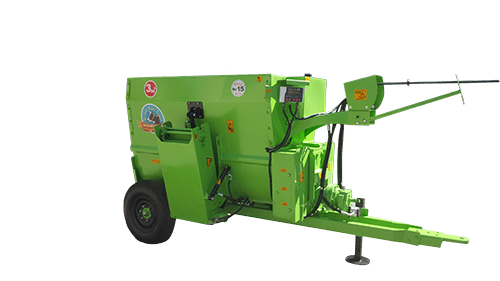
One of the devices that is highly practical and profitable for both traditional and industrial livestock farms is the feed mixer. Livestock farming professionals recognize feed mixers by various names, including feed mixer, feed distributor, and feed maker. Feed mixers derive their power from tractors or electric motors and can also operate as self-propelled units. The feed mixer is utilized to chop and mix the ration for cows or sheep, a method referred to as Total Mixed Ration (TMR). To use the device, it is turned on and the necessary ingredients for the ration—such as alfalfa, straw, concentrate, and other supplements—are properly measured and poured into the feed mixer. Once the TMR is prepared, it is dispensed into the troughs for cows or sheep to consume. This structured feeding process ultimately leads to more regular feeding schedules and increased production efficiency. (Additional benefits of feed mixers are detailed further.)
Naturally, the goal of every enterprise or business owner is to generate profit. It can be stated that this device—the feed mixer—is an essential tool for livestock farms (both for cows and sheep) that brings profitability along with convenience and ease in the feeding process. The good news is that due to the variety of feed mixer capacities available, traditional livestock farms can also benefit from these devices. This is because the feed mixer provides the same level of profitability for traditional farms as it does for industrial farms. It should not be assumed that feed mixers are solely useful for industrial farms. Thanks to advances in science and technology, feed mixers are now manufactured in smaller capacities suitable for traditional farms as well as larger capacities designed for industrial farms.
Key Benefits of the Feeder Mixer or Feed Distributor Device
- Management of Feed Intake and Usage: Thanks to the weighing system integrated into the feeder mixer, it’s possible to accurately monitor the consumption of forage and other inputs.
- Minimized Forage Wastage: The forage is evenly chopped and mixed by the feeder mixer, preventing any wastage.
- Increased Milk Yield: Using uniform and well-managed feed prepared by the feeder mixer contributes to higher milk production levels.
- Improved Milk Fat and Protein Levels: The use of feeder mixers enhances the fat and protein content in milk.
- Improved Digestive Health in Livestock: Reducing digestive issues is one of the benefits of using a feeder mixer.
- Reduced Labor Requirements: The feeder mixer reduces the need for manual labor.
Attention: Professors and those who currently use or have previously used the feeder mixer are encouraged to share additional benefits not mentioned here by visiting the discussion forums. Click here to register those advantages.
Types of Feeder Mixers Based on Movement
- Tractor-Powered Feeder Mixer
- Stationary or Electric Feeder Mixer
Tractor-Powered Feeder Mixer
This type of feeder mixer is suitable for farms where sufficient space is available for tractor movement and turning. The feeder mixer is brought near the forage using the tractor. After loading and completing the mixing process, the feed is delivered on a conveyor system and deposited into the trough via the movement of the tractor.
Stationary or Electric Feeder Mixer
Traditional farms or farms with limited space, where tractor movement is not feasible, often use stationary feeder mixers powered by three-phase electricity. In such cases, the feeder mixer remains fixed in one location. Forage and other additives are loaded into the mixer, and once the TMR (Total Mixed Ration) is prepared, it is transported to the trough using bags or wheelbarrows.




